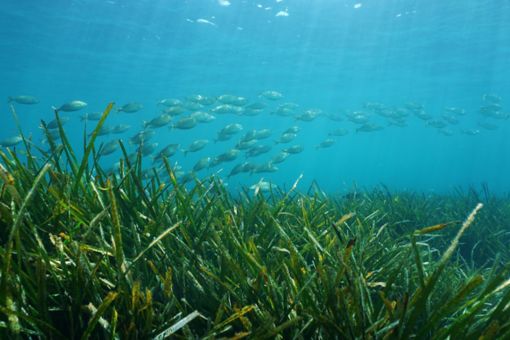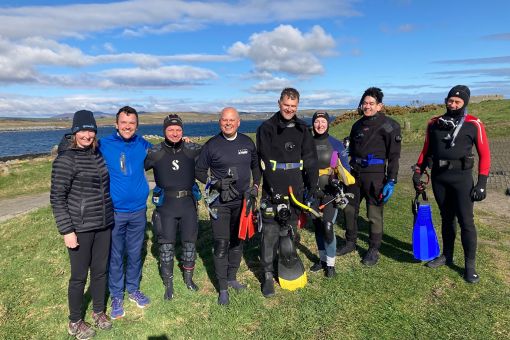Since the Industrial Revolution, humans have emitted more than 2,000 gigatons of CO2 (GtC) into the atmosphere. We are now approaching that well-warned planetary tipping point, with projections acknowledging we are likely to fall short of the Paris Agreement target of 2 (ideally 1.5) degrees Celsius in global warming by 2050.
Scientists predict that up to 10 GtC will need to be removed annually from the atmosphere by 2050, doubling up by 2100. Whilst global consensus has been building on climate action, reducing our carbon emissions on land alone likely won’t be enough[1].
Despite growing attention on our relationship with nature, and a focus on terrestrial solutions like reforestation and new technology investment, many overlook an essential ally in the fight against climate change – the ocean.
You cannot go green without blue
The United Nations has estimated that ocean trade is worth roughly $3 trillion per year, and around 5% of global GDP[2]. Indeed, up to 80% of all planetary life is found under the sea and around its coastlines, supporting 3 billion people through jobs and food security, for example.
And – with every $1 invested in ocean actions delivering an estimated $5 in benefits over a 30-year period[3] (as well as numerous economic, environmental & health benefits) – the integral role oceans play in protecting and providing for our planet cannot be overstated.
In previous research conducted by KPMG, we have outlined that the Blue Economy is central to the green agenda. It has been described as “the sustainable use of ocean resources to promote economic growth, social inclusion and the preservation or improvement of livelihoods – while at the same time ensuring environmental sustainability of the oceans and coastal areas”.

Blue Carbon Ecosystems (BCEs) have also been the topic of previous KPMG research. BCEs including mangroves, seagrasses, tidal and salt marshes - as well as ocean food webs and nutrient cycles - have enormous capacity to store carbon within the plants, animal biomass, and in the sediments below for long periods of time.
Estimated investments in BCEs could reduce emissions by 4 GtC per year in 2030 (40% of forecast global need), and by 11 GtC per year, in 2050. Conversely, when disrupted, BCEs can also release carbon – making it critical to conserve, protect and restore these vital resources.
Blue finance - getting it right
Blue finance for BCEs is also yet to be fully understood or widely adopted. In the 15 years since the term ‘blue carbon’ was first coined, there has been continued degradation and destruction of vital BCEs though human activity. BCEs are critical for thriving biodiversity and provide natural protection from extreme weather events (e.g., storms and floods).
A key finding from our recent report Net zero readiness spotlight: Islands highlighted that 83% of the asset managers surveyed in 2022 were unaware of investment opportunities in the sustainable blue economy in general - and in many small island economies in particular.
Imperfections in delivery have harmed the credibility of carbon offsets, which are just one of the tools to combat climate change. No company wants to be accused of greenwashing (i.e., providing misleading public statements to present an environmentally responsible image). Nor do they want to find themselves investing in nature-based-solutions (NBS) that do not achieve stated objectives.
Positively, global collaboration is growing on methodologies, verification techniques and implementation principles for BCEs. The Blue Carbon Handbook[4] is one such collaboration between the High-Level Panel for a Sustainable Ocean Economy and the International Partnership for Blue Carbon and the Blue Carbon Initiative.
Its purpose is to distil key concepts and information – establishing a clear, consistent understanding of the term ‘blue carbon’ for non-experts. This aims to instil confidence and drive corporate investment into helping solve key global challenges on climate action.
The primary goal here is to ensure marine and coastal ecosystems remain healthy, resilient, and productive - with nature-based solutions becoming key elements in developing coastal infrastructure.
KPMG and seagrass
In our islands, our culture and communities are deeply connected with the ocean, inland coastal waters, and the rich marine biodiversity they contain. Though small compared with other jurisdictions, our islands are also best placed to enact positive change - by tapping into the potential of surrounding BCEs.
One such pioneering approach is a KPMG-sponsored project, which aims to champion a species of seagrass with huge potential for positive impact on local marine health and climate change. In the Isle of Man (IOM), the Manx Eelgrass Group[5] (MEG) – led by the Manx Wildlife Trust – aims to research, protect, and restore eelgrass sites in Manx waters whilst helping deliver the IOM Government’s Blue Carbon Project[6].

Zostera Marina - the name given to the type of seagrass around the IOM – can store carbon 3-5 times faster than a tropical forest. With 90% of seagrass in the British Isles disappearing over the last century, the MEG is committed to helping reverse this trend.
With a boost to future fish stocks – since seagrass provides shelter and food for fish – and potential enhancement to natural flood and storm protection defences, as well as capturing nutrient pollution as it flows from the land to the sea, there are also clear economic benefits.
Bahamas and seagrass
The potential to capture carbon through BCEs is even greater in the Bahamas, where research suggests there is approximately 92,000 square kilometres of seagrass in territorial seas. This accounts for roughly 30% of all seagrass on the planet.
Estimates suggest the Bahamas could be capturing 68 times the amount of CO2 emitted. Forecasts for the creation of blue carbon credits (CC) range from 2.5m by 2024, rising to 10m by 2030 (worth up to $1bn per year in CC revenues based on a CC price of $100)[7].
This could be achieved through restoring and maintaining mangroves and seagrass fields, as well as disincentivising unsustainable practices (such as using mangroves for firewood), though compensation schemes, for example.
In the second part of 'Blue finance for Small Island Economies', I will be delving deeper into what types of emerging blue finance currently exist, the methodologies involved, their benefits and how we can mobilise and maximise blue carbon in our local economies.
How we can help
Ben Tovell is an ESG Associate Director at KPMG, focussing on innovative finance solutions for island economies. For more information on how your business can harness the blue economy in the fight against climate change, email ben.tovell@kpmg.co.im.
[1] Blue carbon ecosystems - KPMG Global
[2] Making waves for a blue economy | United Nations
[3] Sustainable Ocean Economy: Charting a Prosperous Blue Future from Risk to Resilience (Citi, June 2023).
[4] Ocean_Panel_Blue_Carbon_Handbook-1.pdf (oceanpanel.org)
[5] Eelgrass | Manx Wildlife Trust (mwt.im)
[6] The Manx Blue Carbon Project (netzero.im)
[7] The Bahamas: A Complete And Compelling Choice May 2023 by ClearView Financial Media - Issuu


